Midwifery Group Practice: Managing Iron Deficiency Anemia in Pregnancy
VerifiedAdded on 2023/01/07
|7
|1398
|93
Report
AI Summary
This report examines the role of midwifery in providing care for pregnant women, particularly those with iron deficiency anemia. It highlights the effectiveness of various care models, including GP shared care and standard hospital maternity care, in improving maternal health. The report emphasizes the importance of addressing iron deficiency through oral iron therapy, dietary advice, and iron supplements, while also considering potential adverse effects. It also points out the importance of family support and a positive attitude from midwives in enhancing the well-being of pregnant women. The study concludes that midwifery plays a crucial role in providing detailed information, guidance, and support to pregnant women, ultimately contributing to healthier pregnancies. Desklib offers a variety of resources, including past papers and solved assignments, to aid students in their studies.
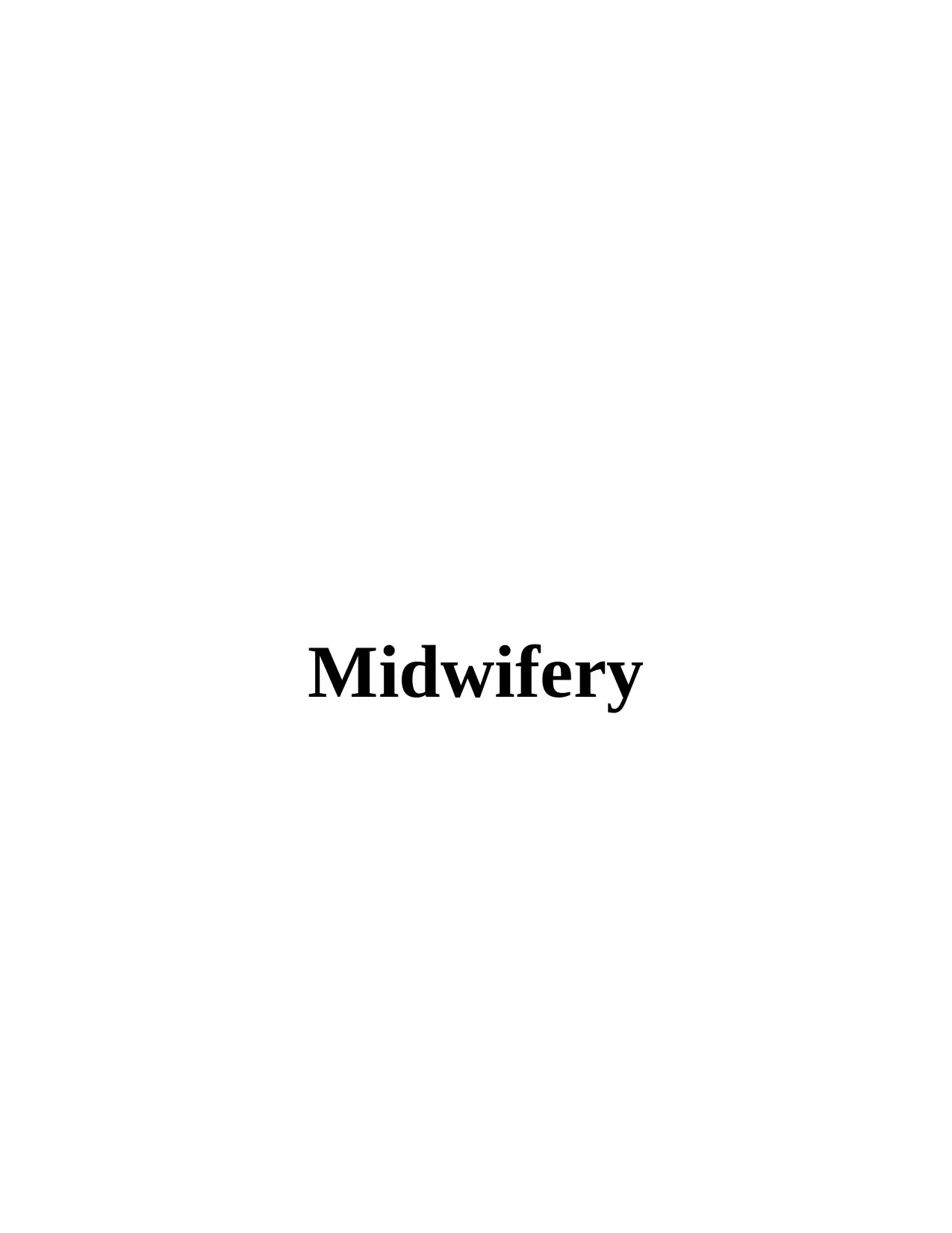
Midwifery
Paraphrase This Document
Need a fresh take? Get an instant paraphrase of this document with our AI Paraphraser
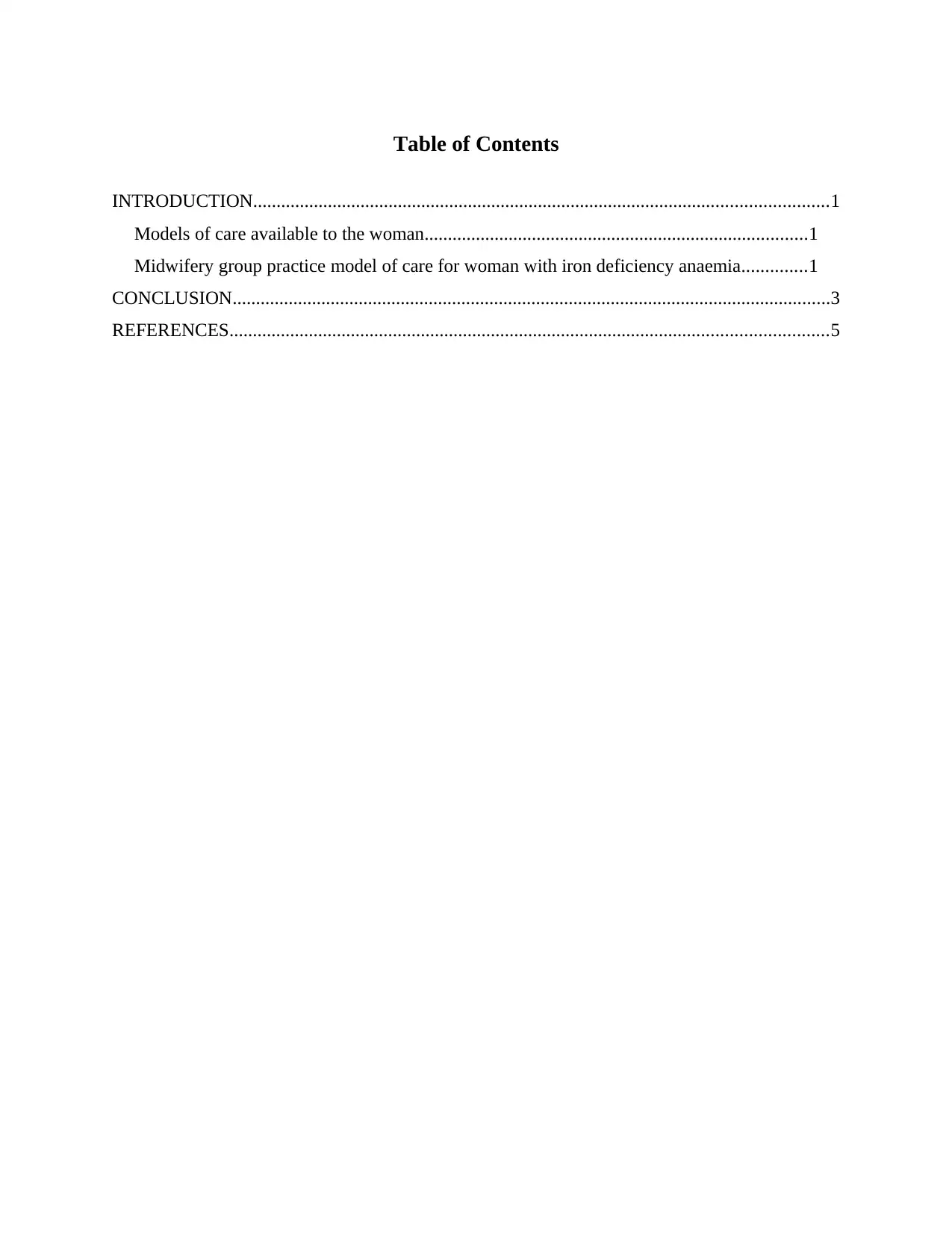
Table of Contents
INTRODUCTION...........................................................................................................................1
Models of care available to the woman..................................................................................1
Midwifery group practice model of care for woman with iron deficiency anaemia..............1
CONCLUSION................................................................................................................................3
REFERENCES................................................................................................................................5
INTRODUCTION...........................................................................................................................1
Models of care available to the woman..................................................................................1
Midwifery group practice model of care for woman with iron deficiency anaemia..............1
CONCLUSION................................................................................................................................3
REFERENCES................................................................................................................................5
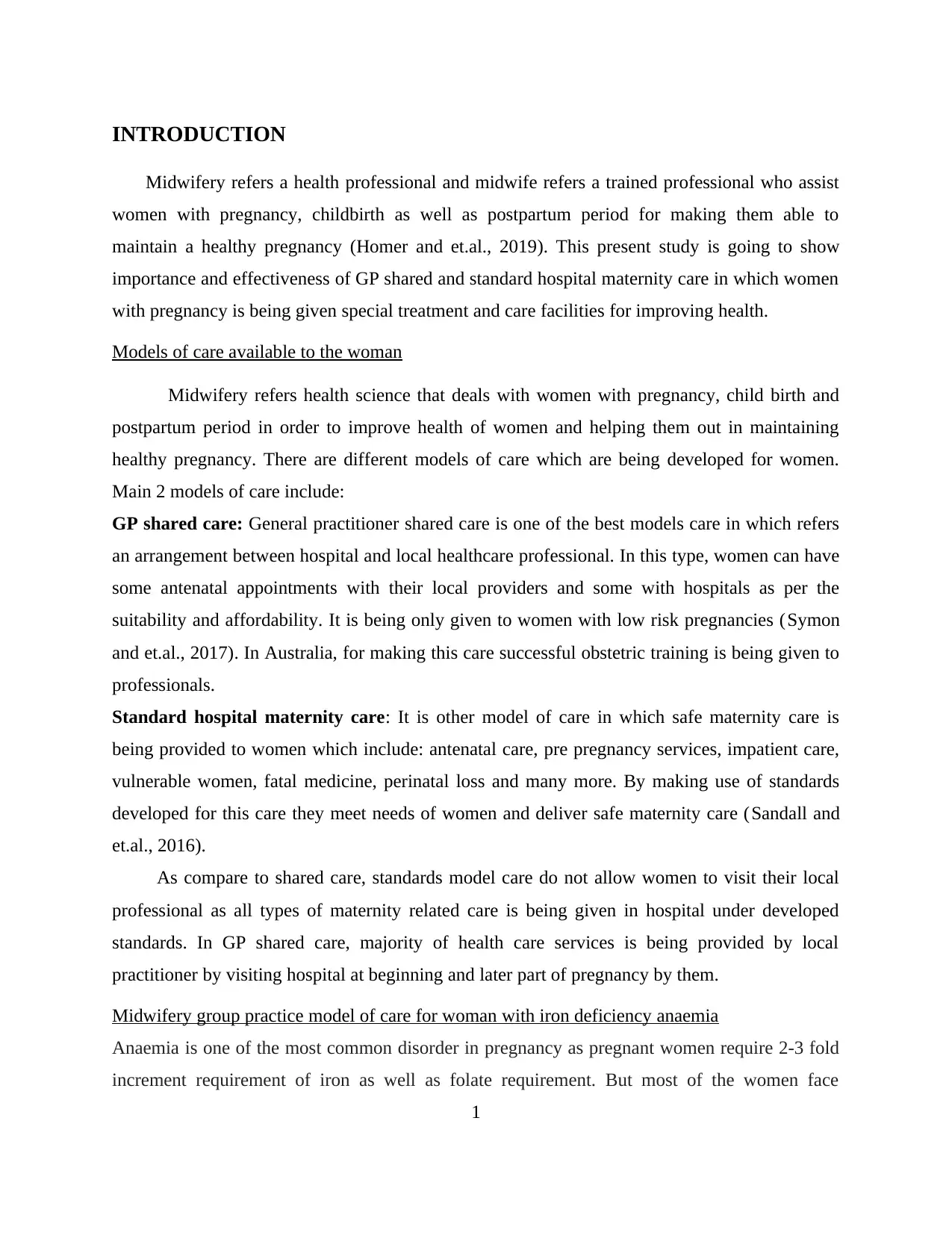
INTRODUCTION
Midwifery refers a health professional and midwife refers a trained professional who assist
women with pregnancy, childbirth as well as postpartum period for making them able to
maintain a healthy pregnancy (Homer and et.al., 2019). This present study is going to show
importance and effectiveness of GP shared and standard hospital maternity care in which women
with pregnancy is being given special treatment and care facilities for improving health.
Models of care available to the woman
Midwifery refers health science that deals with women with pregnancy, child birth and
postpartum period in order to improve health of women and helping them out in maintaining
healthy pregnancy. There are different models of care which are being developed for women.
Main 2 models of care include:
GP shared care: General practitioner shared care is one of the best models care in which refers
an arrangement between hospital and local healthcare professional. In this type, women can have
some antenatal appointments with their local providers and some with hospitals as per the
suitability and affordability. It is being only given to women with low risk pregnancies (Symon
and et.al., 2017). In Australia, for making this care successful obstetric training is being given to
professionals.
Standard hospital maternity care: It is other model of care in which safe maternity care is
being provided to women which include: antenatal care, pre pregnancy services, impatient care,
vulnerable women, fatal medicine, perinatal loss and many more. By making use of standards
developed for this care they meet needs of women and deliver safe maternity care (Sandall and
et.al., 2016).
As compare to shared care, standards model care do not allow women to visit their local
professional as all types of maternity related care is being given in hospital under developed
standards. In GP shared care, majority of health care services is being provided by local
practitioner by visiting hospital at beginning and later part of pregnancy by them.
Midwifery group practice model of care for woman with iron deficiency anaemia
Anaemia is one of the most common disorder in pregnancy as pregnant women require 2-3 fold
increment requirement of iron as well as folate requirement. But most of the women face
1
Midwifery refers a health professional and midwife refers a trained professional who assist
women with pregnancy, childbirth as well as postpartum period for making them able to
maintain a healthy pregnancy (Homer and et.al., 2019). This present study is going to show
importance and effectiveness of GP shared and standard hospital maternity care in which women
with pregnancy is being given special treatment and care facilities for improving health.
Models of care available to the woman
Midwifery refers health science that deals with women with pregnancy, child birth and
postpartum period in order to improve health of women and helping them out in maintaining
healthy pregnancy. There are different models of care which are being developed for women.
Main 2 models of care include:
GP shared care: General practitioner shared care is one of the best models care in which refers
an arrangement between hospital and local healthcare professional. In this type, women can have
some antenatal appointments with their local providers and some with hospitals as per the
suitability and affordability. It is being only given to women with low risk pregnancies (Symon
and et.al., 2017). In Australia, for making this care successful obstetric training is being given to
professionals.
Standard hospital maternity care: It is other model of care in which safe maternity care is
being provided to women which include: antenatal care, pre pregnancy services, impatient care,
vulnerable women, fatal medicine, perinatal loss and many more. By making use of standards
developed for this care they meet needs of women and deliver safe maternity care (Sandall and
et.al., 2016).
As compare to shared care, standards model care do not allow women to visit their local
professional as all types of maternity related care is being given in hospital under developed
standards. In GP shared care, majority of health care services is being provided by local
practitioner by visiting hospital at beginning and later part of pregnancy by them.
Midwifery group practice model of care for woman with iron deficiency anaemia
Anaemia is one of the most common disorder in pregnancy as pregnant women require 2-3 fold
increment requirement of iron as well as folate requirement. But most of the women face
1
⊘ This is a preview!⊘
Do you want full access?
Subscribe today to unlock all pages.

Trusted by 1+ million students worldwide
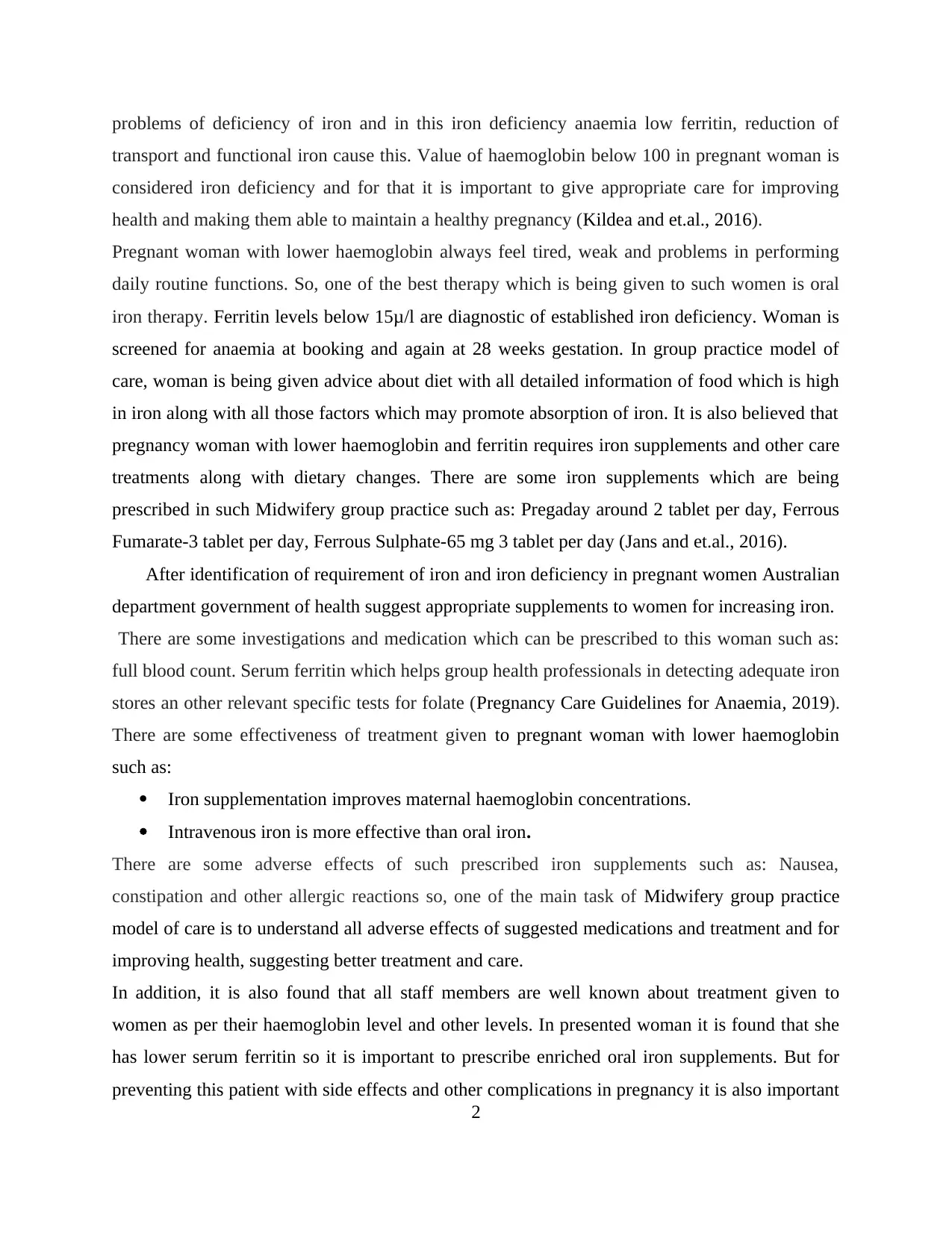
problems of deficiency of iron and in this iron deficiency anaemia low ferritin, reduction of
transport and functional iron cause this. Value of haemoglobin below 100 in pregnant woman is
considered iron deficiency and for that it is important to give appropriate care for improving
health and making them able to maintain a healthy pregnancy (Kildea and et.al., 2016).
Pregnant woman with lower haemoglobin always feel tired, weak and problems in performing
daily routine functions. So, one of the best therapy which is being given to such women is oral
iron therapy. Ferritin levels below 15μ/l are diagnostic of established iron deficiency. Woman is
screened for anaemia at booking and again at 28 weeks gestation. In group practice model of
care, woman is being given advice about diet with all detailed information of food which is high
in iron along with all those factors which may promote absorption of iron. It is also believed that
pregnancy woman with lower haemoglobin and ferritin requires iron supplements and other care
treatments along with dietary changes. There are some iron supplements which are being
prescribed in such Midwifery group practice such as: Pregaday around 2 tablet per day, Ferrous
Fumarate-3 tablet per day, Ferrous Sulphate-65 mg 3 tablet per day (Jans and et.al., 2016).
After identification of requirement of iron and iron deficiency in pregnant women Australian
department government of health suggest appropriate supplements to women for increasing iron.
There are some investigations and medication which can be prescribed to this woman such as:
full blood count. Serum ferritin which helps group health professionals in detecting adequate iron
stores an other relevant specific tests for folate (Pregnancy Care Guidelines for Anaemia, 2019).
There are some effectiveness of treatment given to pregnant woman with lower haemoglobin
such as:
Iron supplementation improves maternal haemoglobin concentrations.
Intravenous iron is more effective than oral iron.
There are some adverse effects of such prescribed iron supplements such as: Nausea,
constipation and other allergic reactions so, one of the main task of Midwifery group practice
model of care is to understand all adverse effects of suggested medications and treatment and for
improving health, suggesting better treatment and care.
In addition, it is also found that all staff members are well known about treatment given to
women as per their haemoglobin level and other levels. In presented woman it is found that she
has lower serum ferritin so it is important to prescribe enriched oral iron supplements. But for
preventing this patient with side effects and other complications in pregnancy it is also important
2
transport and functional iron cause this. Value of haemoglobin below 100 in pregnant woman is
considered iron deficiency and for that it is important to give appropriate care for improving
health and making them able to maintain a healthy pregnancy (Kildea and et.al., 2016).
Pregnant woman with lower haemoglobin always feel tired, weak and problems in performing
daily routine functions. So, one of the best therapy which is being given to such women is oral
iron therapy. Ferritin levels below 15μ/l are diagnostic of established iron deficiency. Woman is
screened for anaemia at booking and again at 28 weeks gestation. In group practice model of
care, woman is being given advice about diet with all detailed information of food which is high
in iron along with all those factors which may promote absorption of iron. It is also believed that
pregnancy woman with lower haemoglobin and ferritin requires iron supplements and other care
treatments along with dietary changes. There are some iron supplements which are being
prescribed in such Midwifery group practice such as: Pregaday around 2 tablet per day, Ferrous
Fumarate-3 tablet per day, Ferrous Sulphate-65 mg 3 tablet per day (Jans and et.al., 2016).
After identification of requirement of iron and iron deficiency in pregnant women Australian
department government of health suggest appropriate supplements to women for increasing iron.
There are some investigations and medication which can be prescribed to this woman such as:
full blood count. Serum ferritin which helps group health professionals in detecting adequate iron
stores an other relevant specific tests for folate (Pregnancy Care Guidelines for Anaemia, 2019).
There are some effectiveness of treatment given to pregnant woman with lower haemoglobin
such as:
Iron supplementation improves maternal haemoglobin concentrations.
Intravenous iron is more effective than oral iron.
There are some adverse effects of such prescribed iron supplements such as: Nausea,
constipation and other allergic reactions so, one of the main task of Midwifery group practice
model of care is to understand all adverse effects of suggested medications and treatment and for
improving health, suggesting better treatment and care.
In addition, it is also found that all staff members are well known about treatment given to
women as per their haemoglobin level and other levels. In presented woman it is found that she
has lower serum ferritin so it is important to prescribe enriched oral iron supplements. But for
preventing this patient with side effects and other complications in pregnancy it is also important
2
Paraphrase This Document
Need a fresh take? Get an instant paraphrase of this document with our AI Paraphraser
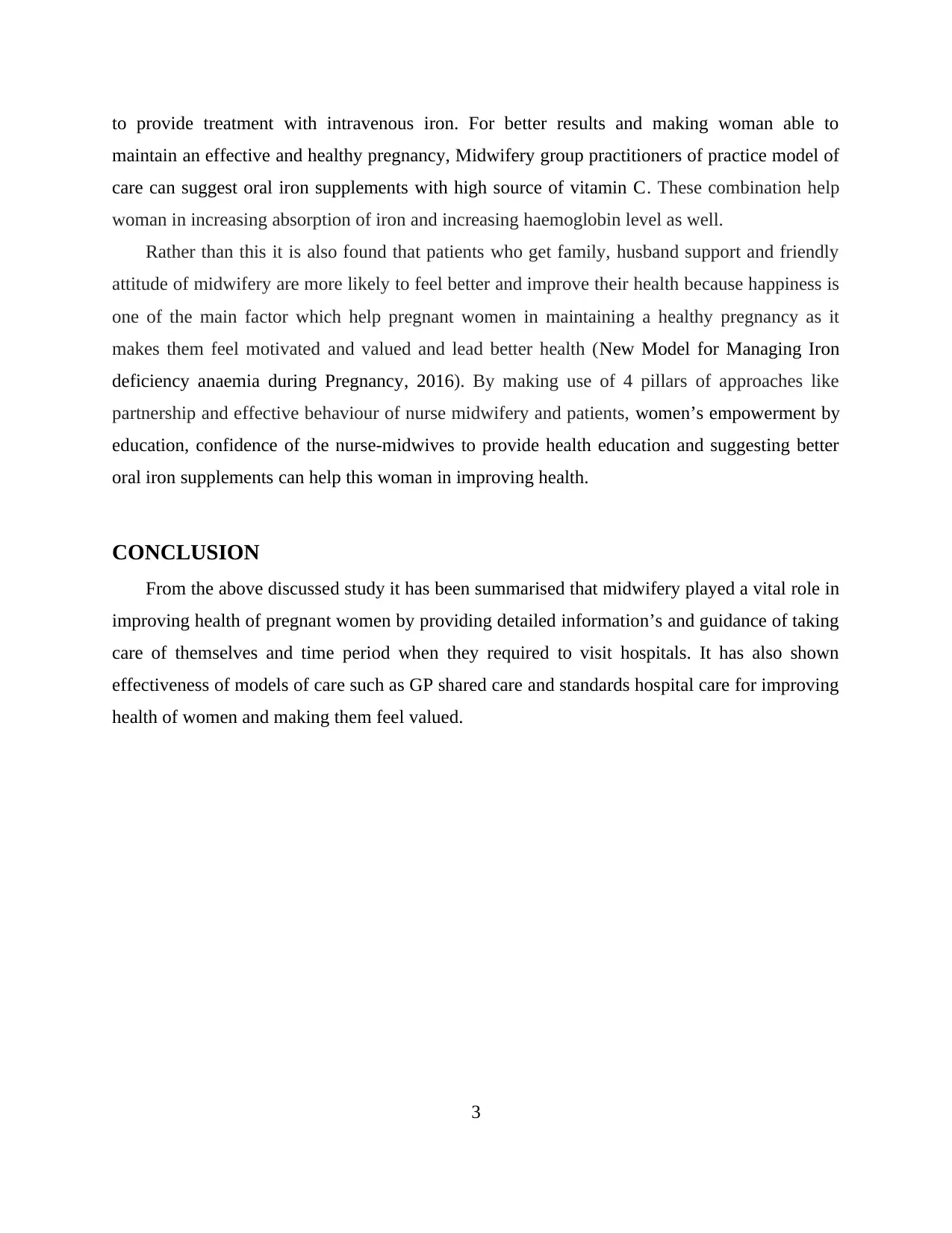
to provide treatment with intravenous iron. For better results and making woman able to
maintain an effective and healthy pregnancy, Midwifery group practitioners of practice model of
care can suggest oral iron supplements with high source of vitamin C. These combination help
woman in increasing absorption of iron and increasing haemoglobin level as well.
Rather than this it is also found that patients who get family, husband support and friendly
attitude of midwifery are more likely to feel better and improve their health because happiness is
one of the main factor which help pregnant women in maintaining a healthy pregnancy as it
makes them feel motivated and valued and lead better health (New Model for Managing Iron
deficiency anaemia during Pregnancy, 2016). By making use of 4 pillars of approaches like
partnership and effective behaviour of nurse midwifery and patients, women’s empowerment by
education, confidence of the nurse-midwives to provide health education and suggesting better
oral iron supplements can help this woman in improving health.
CONCLUSION
From the above discussed study it has been summarised that midwifery played a vital role in
improving health of pregnant women by providing detailed information’s and guidance of taking
care of themselves and time period when they required to visit hospitals. It has also shown
effectiveness of models of care such as GP shared care and standards hospital care for improving
health of women and making them feel valued.
3
maintain an effective and healthy pregnancy, Midwifery group practitioners of practice model of
care can suggest oral iron supplements with high source of vitamin C. These combination help
woman in increasing absorption of iron and increasing haemoglobin level as well.
Rather than this it is also found that patients who get family, husband support and friendly
attitude of midwifery are more likely to feel better and improve their health because happiness is
one of the main factor which help pregnant women in maintaining a healthy pregnancy as it
makes them feel motivated and valued and lead better health (New Model for Managing Iron
deficiency anaemia during Pregnancy, 2016). By making use of 4 pillars of approaches like
partnership and effective behaviour of nurse midwifery and patients, women’s empowerment by
education, confidence of the nurse-midwives to provide health education and suggesting better
oral iron supplements can help this woman in improving health.
CONCLUSION
From the above discussed study it has been summarised that midwifery played a vital role in
improving health of pregnant women by providing detailed information’s and guidance of taking
care of themselves and time period when they required to visit hospitals. It has also shown
effectiveness of models of care such as GP shared care and standards hospital care for improving
health of women and making them feel valued.
3
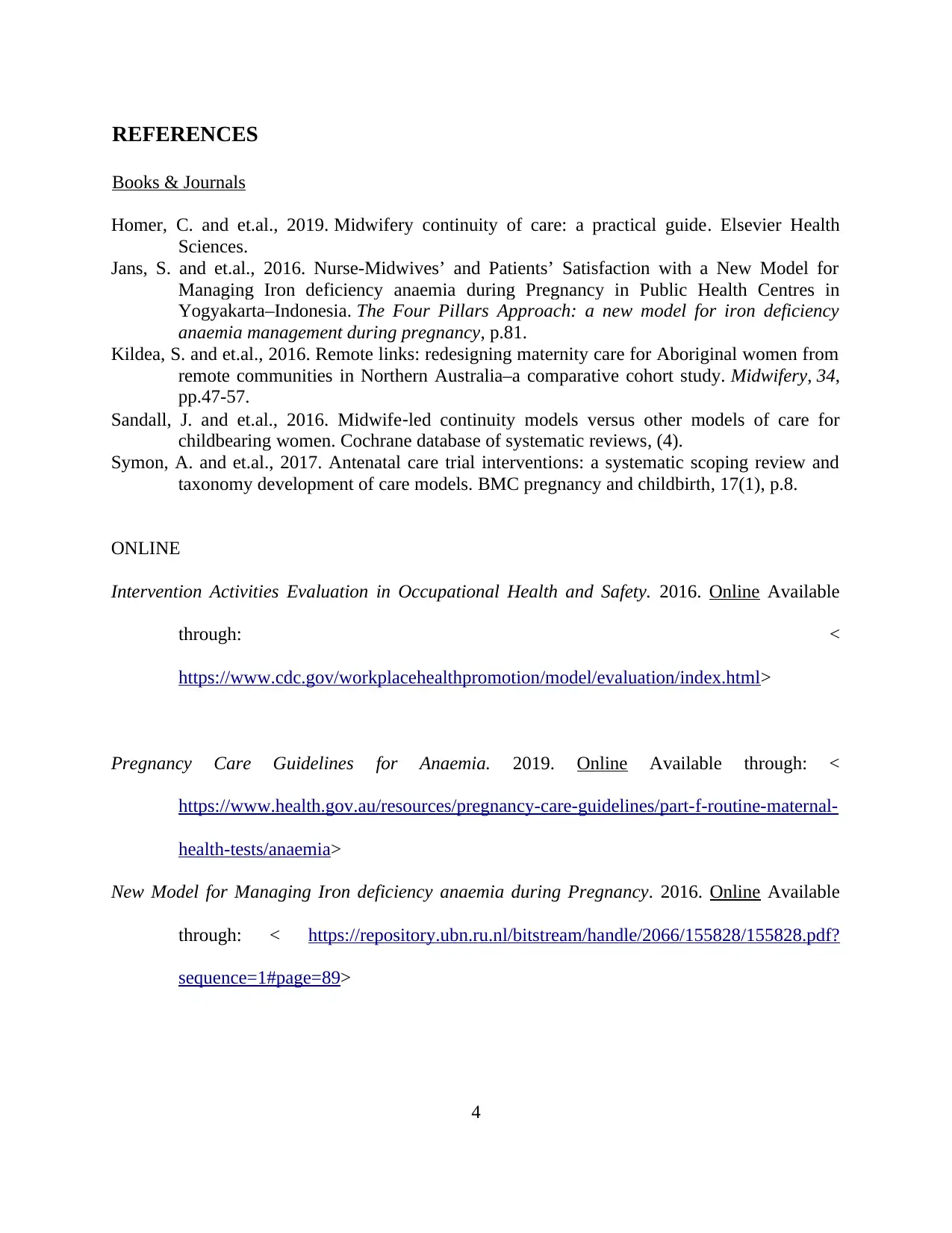
REFERENCES
Books & Journals
Homer, C. and et.al., 2019. Midwifery continuity of care: a practical guide. Elsevier Health
Sciences.
Jans, S. and et.al., 2016. Nurse-Midwives’ and Patients’ Satisfaction with a New Model for
Managing Iron deficiency anaemia during Pregnancy in Public Health Centres in
Yogyakarta–Indonesia. The Four Pillars Approach: a new model for iron deficiency
anaemia management during pregnancy, p.81.
Kildea, S. and et.al., 2016. Remote links: redesigning maternity care for Aboriginal women from
remote communities in Northern Australia–a comparative cohort study. Midwifery, 34,
pp.47-57.
Sandall, J. and et.al., 2016. Midwife‐led continuity models versus other models of care for
childbearing women. Cochrane database of systematic reviews, (4).
Symon, A. and et.al., 2017. Antenatal care trial interventions: a systematic scoping review and
taxonomy development of care models. BMC pregnancy and childbirth, 17(1), p.8.
ONLINE
Intervention Activities Evaluation in Occupational Health and Safety. 2016. Online Available
through: <
https://www.cdc.gov/workplacehealthpromotion/model/evaluation/index.html>
Pregnancy Care Guidelines for Anaemia. 2019. Online Available through: <
https://www.health.gov.au/resources/pregnancy-care-guidelines/part-f-routine-maternal-
health-tests/anaemia>
New Model for Managing Iron deficiency anaemia during Pregnancy. 2016. Online Available
through: < https://repository.ubn.ru.nl/bitstream/handle/2066/155828/155828.pdf?
sequence=1#page=89>
4
Books & Journals
Homer, C. and et.al., 2019. Midwifery continuity of care: a practical guide. Elsevier Health
Sciences.
Jans, S. and et.al., 2016. Nurse-Midwives’ and Patients’ Satisfaction with a New Model for
Managing Iron deficiency anaemia during Pregnancy in Public Health Centres in
Yogyakarta–Indonesia. The Four Pillars Approach: a new model for iron deficiency
anaemia management during pregnancy, p.81.
Kildea, S. and et.al., 2016. Remote links: redesigning maternity care for Aboriginal women from
remote communities in Northern Australia–a comparative cohort study. Midwifery, 34,
pp.47-57.
Sandall, J. and et.al., 2016. Midwife‐led continuity models versus other models of care for
childbearing women. Cochrane database of systematic reviews, (4).
Symon, A. and et.al., 2017. Antenatal care trial interventions: a systematic scoping review and
taxonomy development of care models. BMC pregnancy and childbirth, 17(1), p.8.
ONLINE
Intervention Activities Evaluation in Occupational Health and Safety. 2016. Online Available
through: <
https://www.cdc.gov/workplacehealthpromotion/model/evaluation/index.html>
Pregnancy Care Guidelines for Anaemia. 2019. Online Available through: <
https://www.health.gov.au/resources/pregnancy-care-guidelines/part-f-routine-maternal-
health-tests/anaemia>
New Model for Managing Iron deficiency anaemia during Pregnancy. 2016. Online Available
through: < https://repository.ubn.ru.nl/bitstream/handle/2066/155828/155828.pdf?
sequence=1#page=89>
4
⊘ This is a preview!⊘
Do you want full access?
Subscribe today to unlock all pages.

Trusted by 1+ million students worldwide

5
1 out of 7
Your All-in-One AI-Powered Toolkit for Academic Success.
+13062052269
info@desklib.com
Available 24*7 on WhatsApp / Email
![[object Object]](/_next/static/media/star-bottom.7253800d.svg)
Unlock your academic potential
Copyright © 2020–2025 A2Z Services. All Rights Reserved. Developed and managed by ZUCOL.

